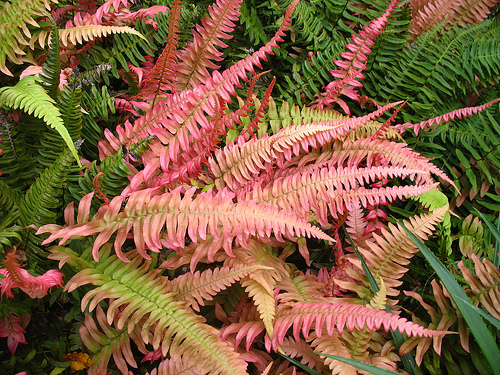|
This is a large group of ferns, which are all pretty easy to cultivate, whether they are hardy or tender. D. Filix-mas (the Male fern) has fronds up to 2 feet long and a foot wide. They are great for placing in open woodland or for shady spots. D. erythrosora, a native of Japan, grows fronds up to 18 inches long. It makes a very lovely houseplant. D. Linnaeana (the Oak Fern) has broad fronds, 6 to 10 inches long.
Pot Cultivation
All of these ferns, whether planted outdoors or in pots as greenhouse or houseplants, will flourish in a soil mixture of equal parts of loam and peat; for pot cultivation, a bit of cow manure should be added. They need a lot of water.
Propagation
The plants can be divided in February and March. After the old soil is removed from the roots, they are separated and repotted individually in 3-inch pots. They can also be reproduced by spores, which are ripe when they are dark brown or yellowish brown. A frond is set in a paper bag and hung in a dry place for a few hours to allow the ripe spores to fall to the bottom of the bag. Sprinkle these thinly on the top of finely sifted compost consisting of equal parts of loam and crushed brick that is in small pans filled halfway with crocks. It is wise to sterilize the compost, crocks and pans by baking before planting the spores. Set a pane of glass over the pots, which are then set in saucers of water. Place the pots of spores in a greenhouse with the required temperature and cover with paper. The prothallia (prothallia are the thin, green, heart-shaped structures that bear a number of root hairs that attach to the soil and extract nourishment) that develop from the spores are pricked out in small clusters and placed half an inch apart in pans of sifted compost. When they're visible as tiny plants just press them into the surface of the compost. They must be kept moist by standing them in water. Don't water them from above until they develop their first small fronds. When they're large enough they can be potted in 3-inch pots and, later, into larger ones. Ferns aren't cross-pollinated as flowering plants are. The spores of two or more kinds are mixed and planted together and hybridization takes place naturally in the prothallia stage. The male element from the prothallia of one kind swims in the film of moisture and enters the female structure on the prothallia of another kind of fern, and fertilization takes place.
 |
| D. erythrosora; |
Varieties
- Hardy kinds -
D. Filix-mas (Male Fern);
D. cristata;
D. erythrosora;
D. fragrans;
D. hexagonoptera (Broad Beech Fern);
D. Linnaeana (Oak Fern);
D. oreopteris (Mountain Wood Fern);
D. Phegopteris (Beech Fern);
D. spinulosa (Spinulose Wood Fern).
-
Greenhouse kinds -
D. Boryana;
D. Brunoniana;
D. chrysoloba;
D. cyatheoides;
D. grandis;
D. Ludoviciana;
D. hirtipes;
D. Sieboldii;
D. Standishii;
D. lepida;
D. truncata.
|





